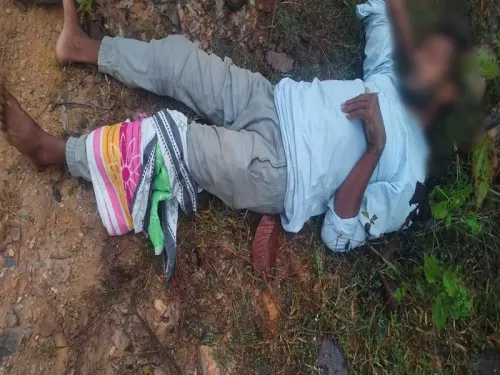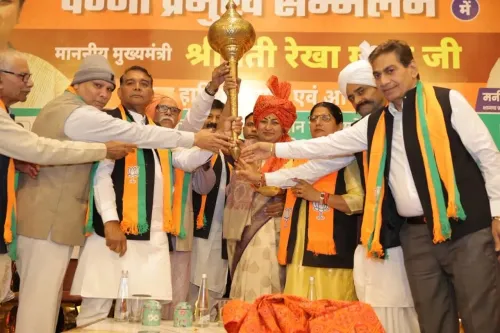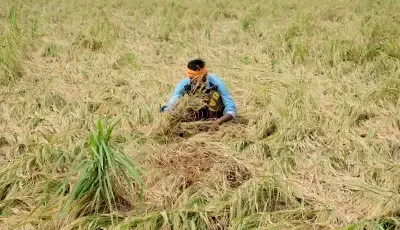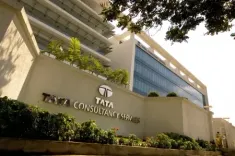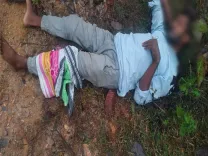What is the significance of the century-old 'Kharchi Puja' in Tripura?

Synopsis
Key Takeaways
- Kharchi Puja is a significant festival in Tripura honoring 14 deities.
- The festival attracts 30 lakh devotees and tourists annually.
- It symbolizes the cleansing of sins for mortal souls.
- Originally a tribal celebration, it is now embraced by various communities.
- The festival's traditions are upheld annually by the Tripura government as per a 1949 merger agreement.
Agartala, July 2 (NationPress) The century-old traditional 'Kharchi Puja' is set to commence on Thursday in the former princely state's earlier capital, Puran Habeli, now known as Khayerpur, located 8 km north of Agartala.
While the seven-day 'Kharchi Puja' and fair will officially initiate on Thursday, the time-honored 'Snan Yatra' of 14 Hindu deities is scheduled for Wednesday evening.
During the months of June and July, the 14 Hindu deities are worshipped together in 'Kharchi Puja', attracting lakhs of participants from various regions of the country and neighboring Bangladesh. This vibrant celebration and fair occur annually, marked by traditional rituals.
The annual 'Kharchi Puja' and festival aim to purify the sins of human souls.
The chairman of the 'Kharchi Puja' and Mela Committee, Ratan Chakraborty, who is also a BJP MLA, mentioned that around 30 lakh devotees and tourists from different parts of the country come together for this extraordinary puja and its traditional rites each year.
"If the weather permits, the turnout of devotees and tourists is expected to surpass last year's figures. However, ongoing issues in Bangladesh may hinder the attendance of many from the neighboring country this year," Chakraborty, a former Minister and Speaker of the Tripura Assembly, conveyed to IANS.
Originally celebrated by Hindu tribals, the Puja has now been embraced by all communities and religions.
With vibrant marquees, lighting, religious ceremonies, and the chanting of 'mantras' amidst drum rhythms, the festival showcases 14 deities: Shiva, Durga, Vishnu, Laxmi, Saraswati, Kartik, Ganesha, Brahma, Abadhi (God of water), Chandra, Ganga, Agni, Kamdev, and Himadri (Himalaya).
According to tradition, the week-long festival begins in June-July with a grand procession, accompanied by the Tripura police music band.
All deities and priests are escorted by Tripura Police personnel, who also provide a guard of honor to the Chief Royal Priest 'Raj Chantaia'.
Notably, among the eight northeastern states, only the Tripura tableau was featured in this year's Republic Day parade on Kartavya Path in New Delhi on January 26.
Historian and author Salil Debbarma indicated that the worship commences with the immersion of 14 deities in the adjacent Howrah river.
On October 15, 1949, Tripura came under the governance of the Indian government following a merger agreement signed by Kanchan Prabha Devi, then regent maharani, and the Indian Governor General. This agreement obligated the Tripura government to maintain the sponsorship of 14 temples, including the Mata Tripura Sundari Temple, recognized as one of the 51 Shakti Peethas in the nation, managed by Hindu princely rulers.
As per the merger pact, the Tripura government has financed the festival for many decades.
"The state government continues to honor the 1949 merger agreement with the royal family, ensuring the faith of tribal communities is upheld yearly," Debbarma told IANS, adding that 'Kharchi Puja' is the most significant festival for Hindu tribals in the northeastern region.
Debbarma remarked, "For more than 78 years, until 1838, Puran Habeli was the capital of then undivided Tripura, which encompassed large sections of Sylhet, Brahmanbaria, and Comilla districts of former East Pakistan, now Bangladesh."
The capital was relocated from southern Tripura's Udaipur to Puran Habeli by King Krishna Manikya Bahadur in 1760.
The temple housing the 14 Gods, built during that period, still exists today. In 1838, the capital transitioned to Agartala under King Krishna Kishore Manikya Bahadur.
(Sujit Chakraborty can be reached at sujitchakrabortyne@gmail.com)

